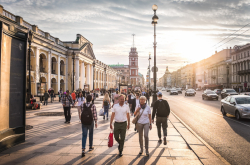You have authored several dozens of projects all over the world. Which of them would you consider your biggest professional challenge?
Any project is always a challenge; I don’t think any single one stands out in particular. They are all unique and pose their own, non-trivial tasks. For example, my latest project was in Atlanta, GA (USA) and involved the renovation of about 1700 acres of land; a massive territory within the city limits, and a rough area, too. Both the government and the local population cast doubt on the project – in the last 20 years, 18 layout plans were developed for the area, none of them ever implemented. Most of the people there didn’t believe it would ever happen. The hardest part of this work was overcoming that doubt. Still, we took up the project, finished the plan and have already provided all the necessary recommendations.
You’ve said that when you left Bombay – your hometown – back in the 70’s, it was a beautiful city, yet, in just a few decades, due to a series of erroneous decisions on the government’s part, it became far from an ideal. What were those mistakes? How is it possible to harm a city through actions like these?
The entirety of Bombay’s infrastructure was originally intended for private transportation. Each road was built with cars in mind; a great deal of resources was put into this. At the same time, public transit was barely financed. When 3% of the city’s population used private cars, it worked fine, but, as it increased to 7%, the system began to break down. Now, instead of developing public transit, the city authorities are channeling funds towards building more roads – which is the same as destroying the city.

Traffic in Bombay
Traffic issues are commonplace for many cities, including Russia.
I haven’t had many chances to see Russia, but I believe that parking spaces are lacking in Russian cities. Parking spots are expensive because they’re costly to maintain. At the same time, most people don’t want to pay for parking, which is a problem, as well. I myself think that cities shouldn’t have free parking altogether. It is not a popular solution, but it is the only way of controlling the traffic in the city. People won’t buy so many cars if they have to pay more to use them. In Australia, an hour of parking costs 30 AUD. Imagine paying such a sum every day. Would you then use your car in the city just as often as you do now?
In addition to St. Petersburg, you’ve also been to Yekaterinburg. What trends have you noticed? What surprised you the most?
From what I’ve seen, here, just like in many other countries, pedestrians and cyclists experience the most discomfort. It’s not easy being a pedestrian, even though one would assume that they are the ones who need the most care, as they don’t use cars and reduce clutter in the city. One of the solutions to this, I believe, would be implementing more spaces and spots for rest; benches. It is especially important when we’re talking about the elderly.
A large land area of a city is, no doubt, a huge advantage – but it is important to use it more effectively, and, in particular, pay attention to the space between buildings. After all, opportunities for leisurely activity should be created not only inside buildings, but outside, as well.

At Dhiru Thadani's lecture at ITMO University
At this year’s World Travel Awards, St. Petersburg was given the prestigious title of Europe’s Leading City Destination. Last year, it was also named the World’s Leading Cultural City Destination. Yet, in St. Petersburg itself, some express the opinion that the city’s reputation as a capital of culture stalls its development. Where do you think can the balance be found between innovation, new trends and preservation of cultural heritage?
I think that, over anything else, St. Petersburg’s historic heritage must be preserved. Specialists need to remember than any new project must fit in with its surroundings, the historic style of the objects in its area. Of course, it is impossible to create something like Times Square or Las Vegas here, as it just won’t merge with the historical background. New solutions must, first and foremost, be respectful of the existing ones. They must not be provoking and, most importantly, historic buildings must not be surrounded with objects taller than they are.
Some cities look good with skyscrapers, but others need to keep their own style. Surely, a city must change, grow and develop, but this has to happen in the context of its existent legacy. This is the key to preserving a city’s charm. On the other hand, there are definitely some pressing issues; today, when walking around the city, I’d noticed that the sidewalks could definitely benefit from some improvements. First off, they require renovation and, secondly, they need to be made more accessible to people with disabilities.
What is to be done with areas that are far from the historic center? For example, the abandoned industrial estates and areas in our city, referred to as the “grey belt”? Different cities around the world have tried different approaches to this issue; which do you believe is the most efficient?
You call it a grey belt, we call it a brownfield. These areas can always be revitalized and reused. We always insist on that approach; such practice is common around the world – dilapidated buildings are passed over to investors for a small price and they, in turn, renovate the area and attract people there. The formula works and have been used in many places. That’s what was done in SoHo, which was once an industrial area. Once the process is finished, real estate prices go up once again, which is a normal, natural occurrence.

SoHo, Manhattan. Credit: artisnewyork.com/depositphotos.com
I believe that this approach is equally applicable to any city. Brownfield renovation is a common practice because, even though they might have been once located on the outskirts, at some point they are taken over by the city and become a nuisance. Production moves to new areas, and what is left after it is used for entertainment, business or simply to improve the city environment.
These days, Big Data and social media analysis are a hot topic – in urban studies, too. How do you use these tools in your work?
Technology and data management are, undoubtedly, important, and we make use of the opportunities they offer us. Still, despite the wide range of tools available these days, we try not to follow their advice blindly. For now, we must be able to process some information on our own, as well as communicate with others.
In your talk, you mentioned a number of challenges that the modern society is facing – the rapid global population growth, fossil fuel depletion, healthcare crises and others. How should today’s educational programs, universities react to these issues; can they prepare specialists to handle them?

Dhiru Thadani's project work for the Congress for the New Urbanism
A university can never fully prepare a student for real life. But I think that it is largely the universities’ responsibility to inform students about these kinds of things, the latest trends and global challenges. As for the students, they need to think in the context of what is happening right now; to keep in mind the current events and to understand what limits exist right now and how they might change in the future.
All we can hope for is that, when they graduate, students will have a sort of checklist where these things are all put together. There is no doubt that real life will cause some confusion and they won’t instantly get what they need to solve all their problems; however, they will have a formidable amount of knowledge in many fields – from issues of climate change and sustainable development to proficiencies in working with new materials and tools. Forming this knowledge is a key necessity in training future specialists.
Dhiru Thadani is an architect and urbanist, a member of the American Institute of Architects, and has worked in many countries since 1980. He has served as head developer of new cities and settlements, authored projects on urban infill. In 2016, he was elected VP-Members of the International Society of City and Regional Planners. A recipient of numerous prestigious awards and memberships, he is also an author of numerous books, including: “The Language of Towns & Cities: A Visual Dictionary”, “The Architecture of Community” (with Léon Krier) and “Visions of Seaside: Foundation, Evolution, Imagination, Built & Unbuilt Architecture”. At the open lecture “Urbanism: The Prescriptive Remedy to Global Crises” at ITMO’s Institute of Design and Urban Studies, he spoke about the work of the International Society of City and Regional Planners, as well as the global trends that will need to be accounted for in the planning of future spaces of modern cities.





